Domestic anti-tank self-propelled artillery. 1-Part I
Before the war in the USSR, numerous attempts were made to create various self-propelled artillery installations (SAU). Dozens of projects were considered, prototypes were built for many of them. But before the mass adoption of the case it never came. The exceptions were: 76-mm anti-aircraft installation 29K on the chassis of the YAG-10 truck (60 pcs.), SAU SU-12 - 76,2-mm regimental gun of the 1927 model of the year on the chassis of the Morland truck or GAZ-AAA (99 pcs.) SAU SU-5-2 - 122-mm howitzer installation on the chassis T-26 (30 pcs.).
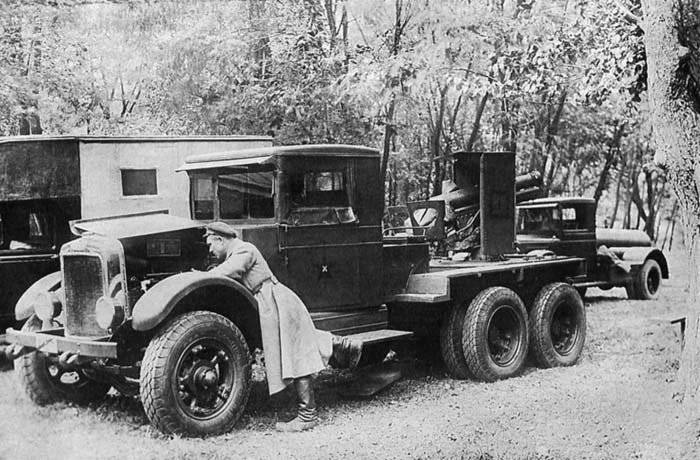
Of greatest interest in anti-tank respect was the SU-6 self-propelled guns not adopted for service on the chassis tank T-26, armed with a 76-mm 3-K anti-aircraft gun. Tests of the installation took place in 1936. The military was not happy that the calculation of the SU-6 in the stowed position did not fit completely on the self-propelled guns and the installers of the remote handsets had to go by escort vehicle. This led to the fact that the SU-6 was deemed unsuitable for escorting motorized columns as a self-propelled anti-aircraft mount.
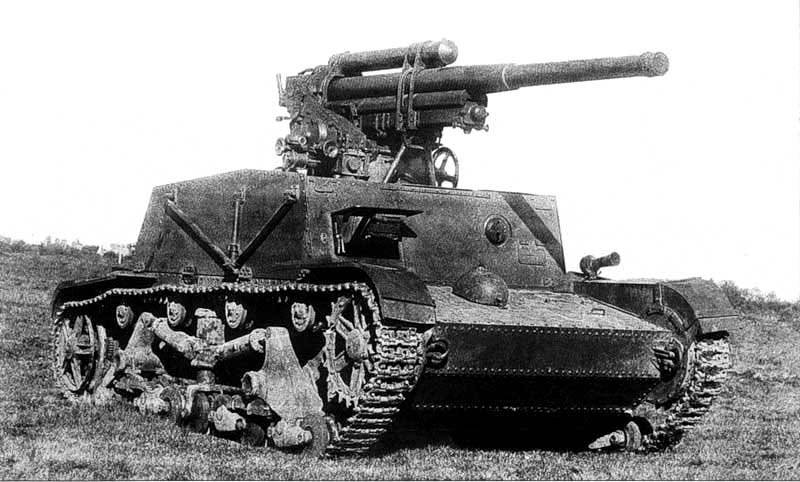
Although the possibility of using it to fight tanks was not considered, self-propelled guns armed with such weapons could be an excellent anti-tank weapon. Released from the 3-K gun, the BR-361 armor-piercing projectile, at a distance of 1000 meters, pierced 82-mm armor along the normal. Tanks with such a booking have become massively applied by the Germans only from 1943 year.
In fairness it should be said that in Germany, at the time of the invasion of the USSR, there were also no serial anti-tank SAU (PT SAU). The first versions of ACS "Artshturm" StuG III armed with short-barreled 75-mm guns and did not have significant anti-tank capabilities.
However, the presence in the production of a very successful machine, allowed in a short time by increasing the frontal armor and installing 75-mm guns with a barrel length 43 caliber, to turn it into anti-tank.
During the very first battles of the Great Patriotic War, the question arose of the need for the earliest possible development of an anti-tank self-propelled artillery installation capable of rapidly changing positions and fighting German tank units that were significantly superior to the Red Army in terms of mobility.
As a matter of urgency, an 57-mm anti-tank gun rev.1941 of the year was installed on the chassis of a light Komsomolets tractor, which had excellent armor penetration. At that time, this weapon confidently hit any German tank in real combat distances.
PT SAU ZIS-30 was a light open-type anti-tank installation.
Combat calculation of the installation consisted of five people. The upper machine gun was mounted in the middle part of the machine body. Vertical pickup angles ranged from -5 to + 25 °, along the horizon - in the 30 ° sector. Shooting was conducted only from a place. The stability of the self-propelled installation when firing was provided with the help of folding coulters located in the rear part of the machine body. For self-defense of the self-propelled unit, a regular DT 7,62-mm machine gun was used, which was installed in the ball joint on the right in the front cabin leaf. To protect the crew from bullets and splinters, an armored shield shield cannon was used, which had a folding upper part. In the left half of the shield for observation there was a special window closed by a movable shield.
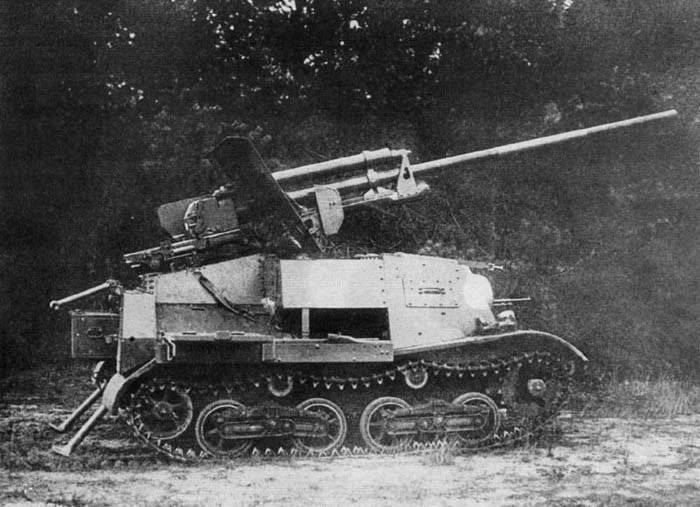
Production of the ZIS-30 continued from September 21 to October 15 of the year 1941. During this period, the plant manufactured a 101 machine with a ZIS-2 cannon (including an experienced machine) and one unit with an 45-mm cannon. Further production of the facilities was halted due to the lack of discontinued Komsomoltsy and the discontinuation of 57-mm guns.
ACS ZIS-30 began to arrive in the troops at the end of September 1941. They were equipped with anti-tank batteries 20 tank brigades of the Western and South-Western fronts.
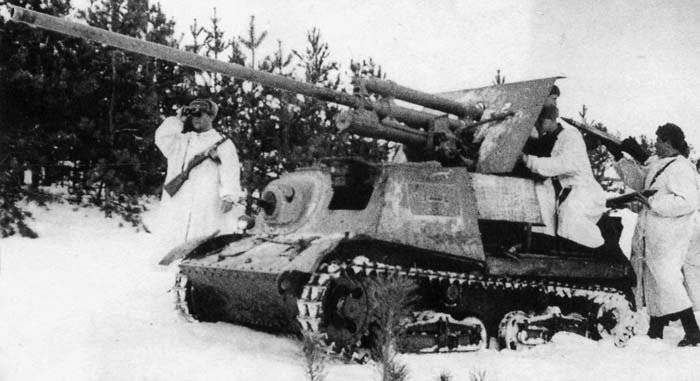
During intensive use of self-propelled guns revealed a number of shortcomings such as poor stability, congestion of the chassis, low power reserve, small ammunition.
By the summer of 1942, in the troops there was practically no PT SAU ZIS-30. Some cars were lost in the battles, and some were out of order for technical reasons.
From January 1943, the mass production of the created N.A. Astrovs based on the T-70 tank, self-propelled 76-mm SU-76 installations (later Su-76М). Although this light SPG was very often used to fight against enemy tanks, it cannot be considered anti-tank. Su-76 armor protection (forehead: 26-35 mm, board and stern: 10-16 mm) protected the crew (4 man) from small arms and heavy fragments.
When used properly, and it did not come immediately (the SAU was not a tank), the SU-76M showed itself well both in defense - in repelling infantry attacks and both mobile, well-defended anti-tank reserves, and in offensive - in suppressing machine-gun nests, destroying pillboxes and bunker, as well as in the fight against counterattacking tanks. The ZIS-3 divisional gun was mounted on the armored vehicle. Her piercing projectile from a distance of 500 meters pierced armor to 91 mm, that is, any place of the body of the German medium tanks and the side of the "panther" and "tiger."
The characteristics of weapons to the SU-76M were very close to the SAU SU-76I, created on the basis of captured German tanks Pz Kpfw III and SAU StuG III. Originally it was planned to install a 76,2-mm ZIS-3Sh (Sh - assault) cannon in the fighting compartment of an SAU, it was this modification of the gun that was installed on the SU-76 and SU-76М serial SAU on a machine fixed to the floor, but this installation did not provide reliable gun protection embrasures from bullets and shrapnel, as during the lifting and turning of the gun in the shield there were always cracks. This problem was solved by installing a special self-propelled 76 mm C-76,2 gun instead of the 1-mm divisional gun. This gun was designed on the basis of the design of the tank gun F-34, which was equipped with tanks T-34.
With the same firepower with SU-76M, SU-76I was much more suitable for use as an anti-tank because of better security. The forehead of the hull had spalive reservations thick — 50-mm.
The production of SU-76I was finally stopped at the end of November 1943 of the year in favor of SU-76M, which had already got rid of "childhood diseases" by that time. The decision to cease production of the SU-76I was associated with a reduction in the number of Pz Kpfw III tanks used on the Eastern Front. In connection with this, the number of captured tanks of this type decreased. A total of 201 ACS SU-76Is (including 1 experienced and 20 commanders) were released, which took part in the 1943-44 battles, but due to the small number and difficulties with spare parts, they quickly disappeared from the Red Army.
The first specialized, domestic PT SAU capable of operating in combat formations on a par with tanks, became the SU-85. This car became especially in demand after the appearance on the battlefield of the German tank PzKpfw VI "Tiger". The armor of the "Tiger" was so thick that the F-34 and ZIS-5, mounted on the T-34 and КВ-1, with great difficulty and only at self-destructively close distances could penetrate.
Special firing at a captured German tank showed that the M-30 howitzer mounted on the SU-122 had an insufficient rate of fire and low flatness. In general, it turned out to be poorly adapted for firing at rapidly moving targets, although it possessed good armor after the introduction of cumulative ammunition.
By order of the GKO of 5 in May of 1943, the design bureau, under the leadership of F.F. Petrov, launched work on installing 85-mm anti-aircraft guns on the chassis of SU-122.
The D-5 gun had a 48,8 caliber with a barrel, the range of direct fire reached 3,8 km, the maximum possible one - 13,6 km. The range of elevation angles ranged from −5 ° to + 25 °, the sector of horizontal shelling was limited to values ± 10 ° from the longitudinal axis of the machine. Ammunition guns made 48 shots unitary loading.
According to Soviet data, the 85-mm BR-365 armor-piercing projectile pierced normally at a distance of 500 and an armor-plate with a thickness of 111 mm, at twice the greater distance under the same conditions - 102 mm. The sabot projectile BR-365P at a distance of 500 m along the normal pierced through an armor plate with a thickness of 140 mm.
Department of management, engine and transmission remained the same as that of the T-34 tank, which allowed staffing crews for new cars practically without retraining. For the commander in the roof of the cabin, an armored cap with prismatic and periscopic devices was welded. On self-propelled installations of later releases, the armor cap was replaced by a commander's turret, as in the T-34 tank.
The overall layout of the machine was similar to the layout of the SU-122, the only difference was in armament. The security of the SU-85 was similar to the T-34.
The cars of this brand were produced at Uralmash from August 1943 to July 1944, in total 2337 self-propelled guns were built. After developing a more powerful self-propelled SU-100 due to the delayed release of 100-mm armor-piercing shells and the discontinuation of the production of armored corps for the SU-85 from September to December, the transitional version of the SU-1944M was produced. In fact, it was a SU-85 with a 100-mm D-85 gun. From the original version of the SU-5, the upgraded SU-85М was distinguished by a more powerful frontal armor and increased ammunition. A total of 85 machines were built.
Thanks to the use of the SU-122 case, it was possible very quickly to start mass production of PTs SAU SU-85. Acting in the battle formations of tanks, they effectively supported our troops with fire, striking German armored vehicles from the 800 — 1000 distance. The crews of these self-propelled guns especially distinguished themselves when crossing the Dnieper, in the Kiev operation and during the autumn-winter battles on Right Bank Ukraine. Apart from the few KV-85 and EC-1, before the appearance of the T-34-85 tanks, only the SU-85 could effectively deal with the enemy’s average tanks at distances of over a kilometer. And at smaller distances and pierce the frontal armor of heavy tanks. At the same time, the very first months of using the SU-85 showed that the power of its guns is insufficient to effectively combat the enemy’s heavy tanks, such as the Panther and the Tiger, which, with their advantage in firepower and defense, as well as effective sighting systems, imposed the fight from long distances.
The SU-1943 built in the middle of the 152, and later, the MIS-122 and the MIS-152 appeared later hit any German tank. But they were not very suitable for fighting tanks because of the high cost, bulkiness and low rate of fire.
The main purpose of these machines was the destruction of fortifications and engineering structures and the function of fire support for the advancing units.
In the middle of the 1944 of the year, under the leadership of F. F. Petrov, an even more powerful 34-mm D-100С gun was designed using shots of the B-10 naval anti-aircraft gun. Gun D-10 arr. 1944 (index “C” - self-propelled version), had a barrel length in 56 calibers. An armor-piercing projectile from a distance of 2000 meters hit armor with a thickness of 124 mm. High-explosive fragmentation projectile with a mass of 16 kg allowed to effectively hit manpower and destroy enemy fortifications.
Using this weapon and the base of the T-34-85 tank, the designers of Uralmash quickly developed the tank destroyer SU-100 - the best anti-tank SAU of the second world war. Compared to the T-34, the frontal armor was enhanced to 75-mm.
The gun was installed in the frontal cutting plate in a cast frame on double trunnions, which allowed its guidance in a vertical plane ranging from −3 to + 20 ° and in the horizontal ± 8 °. The guide was carried out using a manual lifting mechanism of the sector type and a rotating mechanism of the screw type. Ammunition of the gun consisted of 33 unitary shots, placed in five ways in the wheelhouse.
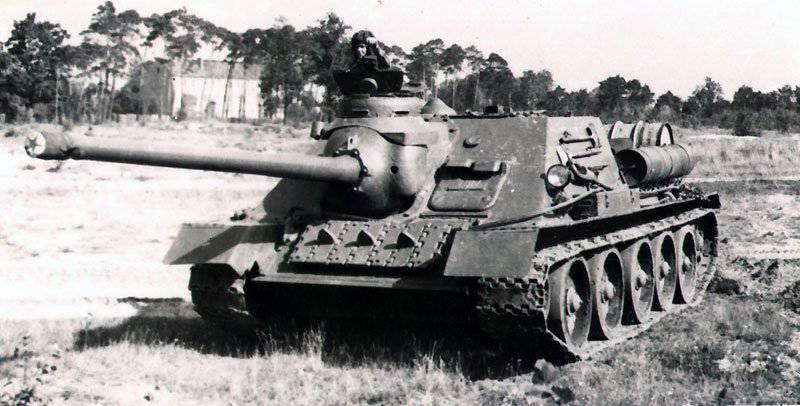
Su-100 possessed exceptional firepower for its time and was able to fight enemy tanks of all types at all distances with aimed fire.
Serial production of the SU-100 began at Uralmash in September 1944. Until May 1945, the plant had time to produce more than 2000 of these machines. The release of the SU-100 on the Uralmash was conducted at least until March of the 1946 year. Omsk plant number 174 1947 in the year released 198 SU-100, and 6 - at the beginning of 1948 year, totally releasing 204 machines. The release of SU-100 in the post-war period was also organized in Czechoslovakia, where in 1951 — 1956, another 1420 SAU of this type was released under license.
In the postwar years, much of the SU-100 was modernized. They appeared night observation devices and sights, new fire and radio equipment. A shot with a more effective armor-piercing projectile UBR-41D with protective and ballistic tips, and later with sabot and non-rotating cumulative projectiles was introduced into the ammunition. The standard ammunition ammunition in the 1960-s consisted of 16 high-explosive fragmentation, 10 armor-piercing and 7 cumulative projectiles.
Having one tank with the T-34, SU-100 was widely distributed around the world, officially in service in more than 20 countries, they were actively used in numerous conflicts. In a number of countries, they are still in service.
In Russia, the SU-100 could be found "in storage" until the end of the 90-x.
Based on:
http://dic.academic.ru/dic.nsf/enc_tech/4200/СУ
http://www.tankovedia.ru/catalog/sssr/su
http://voencomrus.ru/index.php?id=120
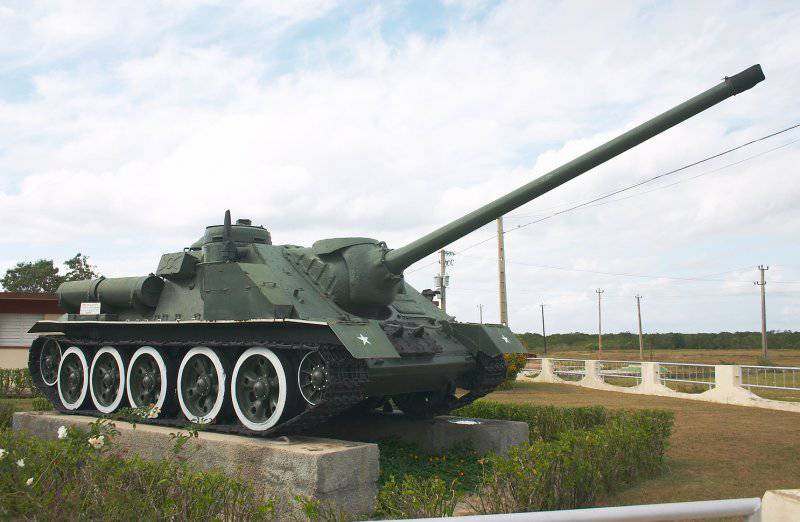
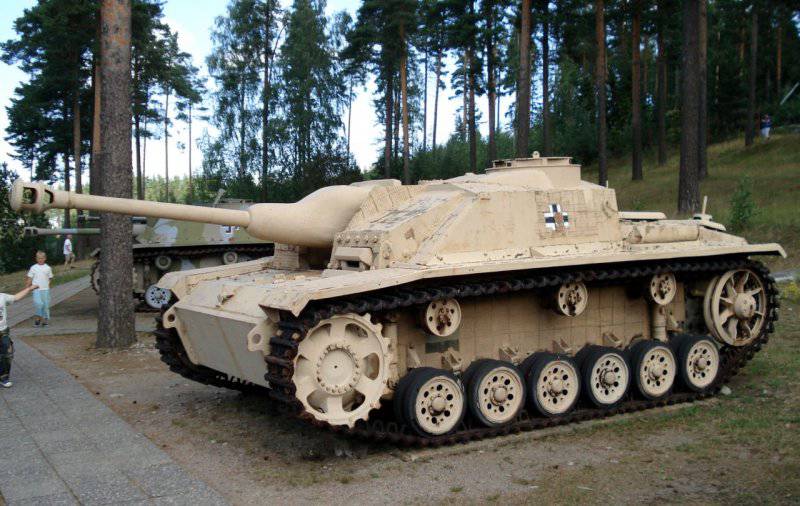
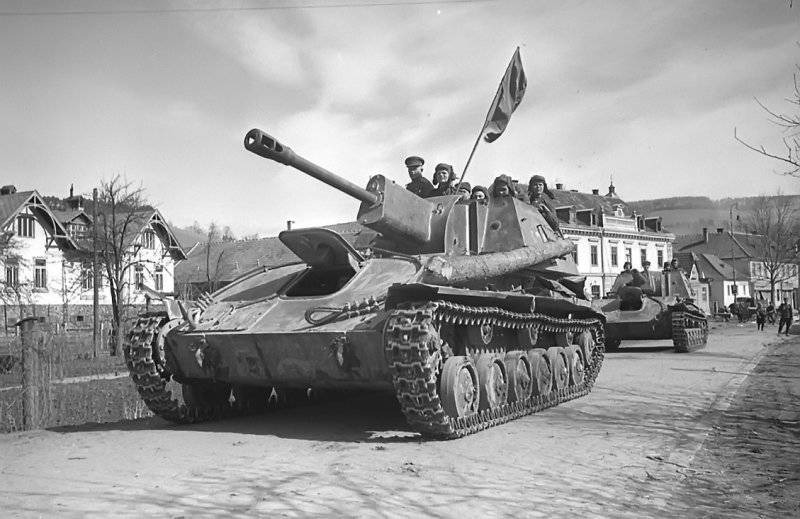
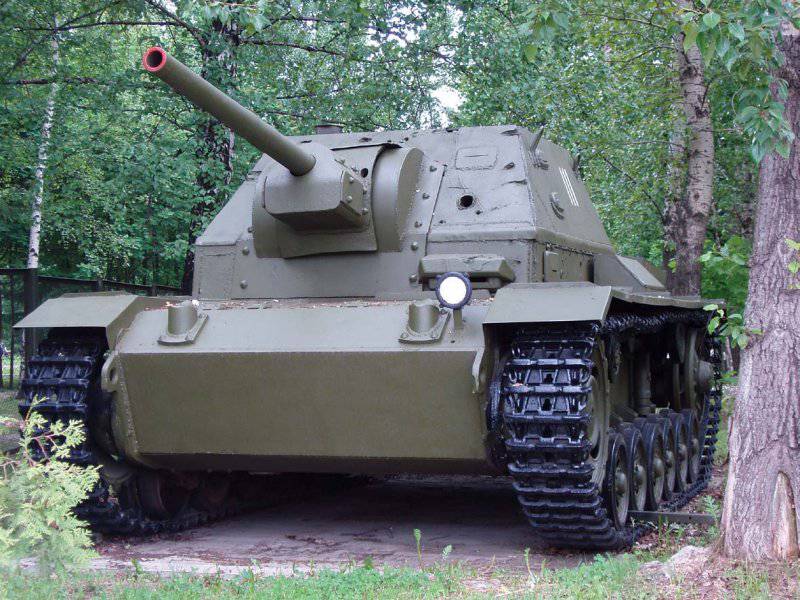
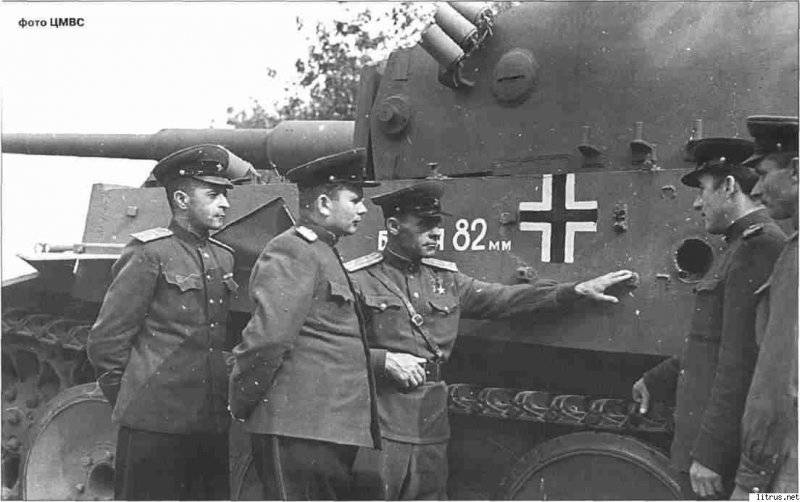
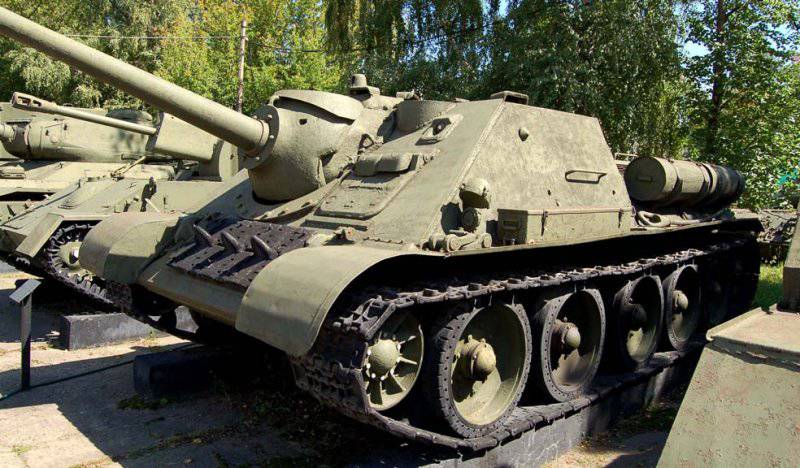
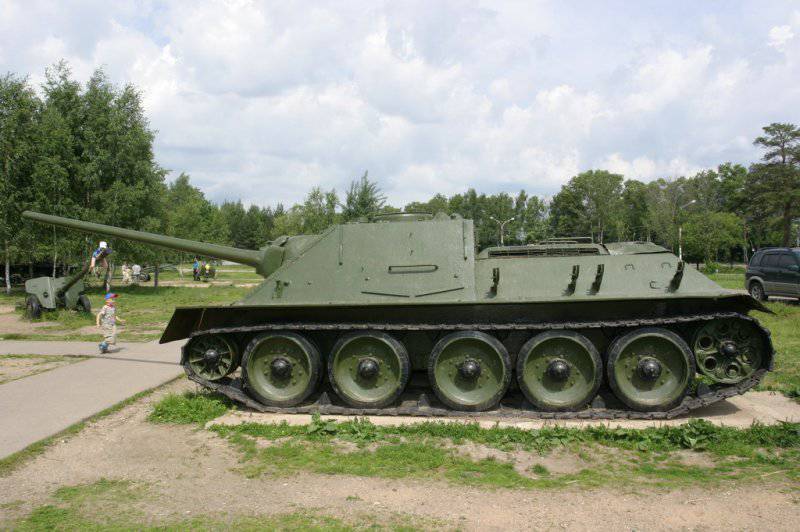
Information